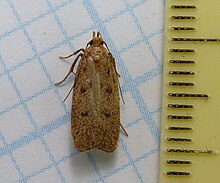
Globia sparganii, or Webb's wainscot, is a moth of the family Noctuidae. The species was first described by Eugenius Johann Christoph Esper in 1790. It is found in Europe, Central Asia, from southern Siberia to Manchuria, Korea, Turkey, Syria and Iran.
Endobrachys is a monotypic moth genus in the family Megalopygidae. It contains only one species, Endobrachys revocans, which is found in Peru, French Guiana and Brazil.
Syllepte leucographalis is a moth in the family Crambidae. It was described by George Hampson in 1912. It is found in Indonesia (Bali).
Dichomeris ligyra is a species of moth in the family Gelechiidae. It was described by Edward Meyrick in 1913. It is found in Gauteng, South Africa.
Idiophantis chiridota is a moth of the family Gelechiidae. It was described by Edward Meyrick in 1914. It is found in Sri Lanka, Thailand, on the Sunda Islands and Fiji.
Glyphidocera vestita is a moth in the family Autostichidae. It was described by Walsingham in 1911. It is found in Panama.
Glyphidocera elpista is a moth in the family Autostichidae. It was described by Walsingham in 1911. It is found in Panama.
Glyphidocera reparabilis is a moth in the family Autostichidae. It was described by Walsingham in 1911. It is found in Panama.
Glyphidocera rhypara is a moth in the family Autostichidae. It was described by Walsingham in 1911. It is found in Mexico.
Glyphidocera plicata is a moth in the family Autostichidae. It was described by Walsingham in 1911. It is found in Panama.
Glyphidocera exsiccata is a moth in the family Autostichidae. It was described by Edward Meyrick in 1914. It is found in Guyana.
Glyphidocera inurbana is a moth in the family Autostichidae. It was described by Edward Meyrick in 1914. It is found in Guyana.
Glyphidocera floridanella is a moth in the family Autostichidae. It was described by August Busck in 1901. It is found in North America, where it has been recorded from Florida and Georgia.
Glyphidocera audax is a moth in the family Autostichidae. It was described by Walsingham in 1892. It is found in the West Indies.
Glyphidocera recticostella is a moth in the family Autostichidae. It was described by Walsingham in 1897. It is found in the West Indies, where it has been recorded from Grenada.
Sceptea aequepulvella is a moth in the family Autostichidae. It was described by Vactor Tousey Chambers in 1872. It is found in North America, where it has been recorded from California, the District of Columbia, Florida, Illinois, Indiana, Kentucky, Maine, Maryland, Mississippi, New Jersey, North Carolina, Ohio, Pennsylvania, South Carolina, Virginia and West Virginia.
Stenoma nebrita is a moth of the family Depressariidae. It is found in Panama, Costa Rica and Guyana.
Stenoma staudingerana is a moth of the family Depressariidae. It is found in the Colombia, French Guiana and Pará, Brazil.
Gonioterma aesiocopia is a moth in the family Depressariidae. It was described by Lord Walsingham in 1913. It is found in Mexico and Panama.
Stenoma symmicta is a moth in the family Depressariidae. It was described by Lord Walsingham in 1913. It is found in Panama and Guyana.


